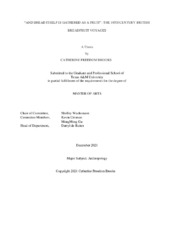| dc.description.abstract | The first trans-Atlantic exchanges of flora and fauna occurred on Christopher Columbus’ initial journey to the American continent in 1492 and initiated a process that Alfred Crosby has termed the “Columbian Exchange”. ¹ Though the movement of plants across the landscape – live, dried, as seeds, or otherwise – had begun long before, the centuries following Columbus’ voyages witnessed an unprecedented reorganization of the natural world. Spearheaded by Europe’s imperial and colonial powers – and enabled by the emergence of scientific societies and the institutionalization of knowledge in that same period – botanicals were sought out, shipped, and transplanted all over the globe. This thesis addresses the history of this transportation of live plants and other floral specimens aboard 18th century European sailing ships, using as a case study the British efforts to transplant the breadfruit tree (Artocarpus altilis) from its native South Pacific islands to the West Indies. From its first references in travellers’ accounts such as those by William Dampier and George Forster, breadfruit was depicted as an almost miraculously versatile and nutritious foodstuff. Always looking for cost-reducing measures for its colonial plantations, the British empire equipped two expeditions, both captained by William Bligh, to bring breadfruit to the Atlantic sphere with the intention of making it a cheap staple for the diet of enslaved workers. The first expedition aboard HMS Bounty (1787-1790) failed due to a mutiny. The second, that of HMS Providence and HMS Assistant (1791-1793), loaded 2,126 breadfruit plants in Tahiti in the Pacific, and delivered its 690 surviving specimens to the botanic gardens of St. Vincent and Jamaica in the West Indies in the largest botanical transfer of its kind to have ever been attempted, and successfully carried out, at the time.
¹ Crosby, 1972. | |


